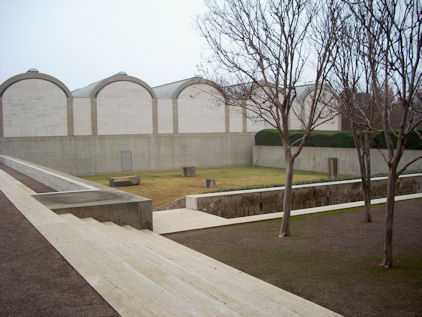Constant readers might remember me mentioning once or twice, in previous posts, the fact that Fort Worth outshines Dallas as the cultural center of DFW. While some of us on the East side of the Metroplex may not like to hear this, that doesn’t lessen the fact that the statement is true. The Kimball Art Museum is an excellent case in point. Although Dallas has its share of fine art museums, none are as famous — or as well advertised, frankly — as the Kimball.
The Kimball Art Museum is set amid a huge expanse of lawn right across the street from the Will Rogers Memorial Center; the Amon Carter Museum is located just down the same street, and it’s maybe half a mile to the National Cowgirl Museum and Hall of Fame. The Kimball is kind of plain from the outside, though of course there are a few decorative elements. For example, I rather liked this sunken rock garden at the back, not to mention the water feature along one side.


Then there’s this guy, who’s one of a few interesting statues surrounding the museum.

I didn’t catch the name of this statue or its artist; as you can probably tell by the quality of the photos, it was a cold, wet, bleak day when I took these pictures, and <> by that point I was ready to get inside. I have to admit that I’m fond of this composition, though. It has a lot of color and energy, and I found its shape intriguing. Rather like a mutant Gumby.
I’ve visited the Kimball twice now, though I only paid to see the special exhibitions once; the second time, the day I took these pictures, I just browsed the permanent collection. I wasn’t interested in the current special exhibition, “Picturing the Bible: The Earliest Christian Art” (which will be on hand until March 30), but the permanent collection is always worth another look. The Kimball maintains a relatively small collection of about 350 paintings and other works. It’s pretty eclectic, the only uniting theme being, as they put it, “an extraordinary level of artistic quality and importance.” They’ve got works by Caravaggio, Matisse, Mondrian, Picasso, Monet, Cezanne, Rembrandt, Goya, and others — so while it’s not huge, it’s nothing to sneeze at. I’ve always been particularly taken by “The Cardsharps,” a Caravaggio painting from the 1590s (more than four hundred years ago!) that shows two cardsharps cheating a young man. It’s magnificent. The color, composition, and detail are incredible, and it’s in an excellent state of preservation. Most of the other paintings are also excellent, though some, like “The Allen Brothers” by Henry Raeburn, a portrait of two young boys from the 1790s, are particularly striking.
Before this past December, I last visited back when the Museum was hosting a huge, elaborate ancient Assyrian exhibit; that was probably ten years ago. We wondered through the exhibits with our self-guided tour tapes, and it was fantastic. The Assyrian civilization dates from about 2,000-612 BC, and they left plenty of traces in what is now Iraq and the surrounding areas. Most prominent in the exhibit were the huge marble panels that had been hacked from the walls of Nineveh and other ancient ruins back in the 19th century by British archaeologists. While I understand their desire to protect these panels, which were no doubt rapidly weathering, it still makes me cringe when I hear about them damaging the sites like that. We’d never get away with that in the New World.
The ancient Assyrians had a distinct artistic style, something like classical Egyptian art in its stiffness; however, there are a lot of distinctive elements, like the curlicue beards and hair, that sets them apart. They were very, very good at rock carving, too; they even had techniques for fixing errors in this unforgiving medium, which the tour tapes pointed out when we wouldn’t have noticed otherwise. They were pretty advanced people, for a Bronze Age culture; in fact, they were one of the first true civilizations. They had chariots, built impressive stone structures, constructed pontoon bridges to span rivers, and of course left behind a lot of impressive permanent art. They also fought lions a lot, to judge from one recurrent theme on the carved panels. It’s odd to think of lions as being native to Mesopotamia, but apparently they were much more widespread in ancient times than they are now.
The panels were really something, but as a writer, I was especially impressed by the cylinder seals and cuneiform tablets, which to my surprise were basically fat rectangular lumps that they inscribed on all sides. It was incredible, seeing this early form of writing firsthand. Cuneiform was one of the earliest forms of writing, and you know what it was used for? Inventories and debts, mostly. It was the easiest way to keep track of taxes owed. Thanks for all the bureaucracy, Assyrians!
The Kimball Art Museum is worth a visit just to see its lovely permanent collection, but the management does make an effort to rotate a new special exhibit through every five or six months. It’s located at 3333 Camp Bowie Boulevard in Fort Worth. Hours of operation are Tuesday-Thursday and Saturday, 10 AM-5 PM; Friday, noon to 8 PM; and Sunday, noon to 5 PM. It’s closed on Mondays, New Year’s Day, the Fourth of July, Thanksgiving, and Christmas. Admission to the permanent exhibits is always free, though there’s a charge for the special exhibits; the fee varies according to the exhibit. However, they’re half-price all day Tuesday, and on Friday from 5-8 PM. Flash photography is not allowed in any of the exhibits, but you can take non-flash photos in the permanent collection area. Beware, though — the lighting isn’t always the best for that kind of photo, even for a digital camera, as I discovered.
